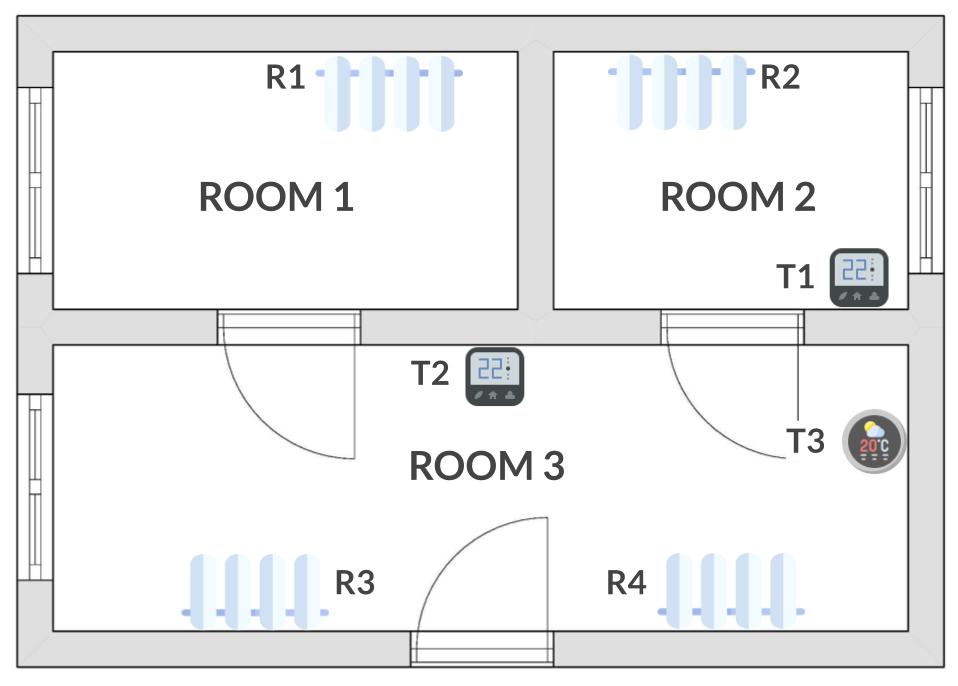Radiator Type (Winter)

The radiators typology is suitable for a home heated by wall-mounted radiators, connected to a heat pump that produces technical hot water.
A house with various possible setups is represented by the diagram, in particular there are:
- no. 3 rooms (Room 1 - Room 3)
- no. 4 Radiators (R1 - R4)
- no. 3 Thermostats / Smart temperature sensors (T1 - T3)
Each room schematizes a possible different setup that can be used as an example to adapt to your case, below is an explanation of the configuration and how it must be implemented on the Home Assistant in order to use Homsai correctly.
Room 1 (one Radiator and one Zone Thermostat)
Room 1 has a radiator (R1) inside.
The house has only one zone thermostat (T2) which manages the air conditioning, connected directly to the heat pump by consent. When the thermostat T2 requests heat, the following are automatically activated:
- Heat pump
- Recirculation pump
- Any solenoid valves present on the technical circuit
In order to convey hot water to the radiators (R1, R2, R3, R4).
In this case Home Assistant must contain:
- An
arearepresenting the climate zone covered by thermostat T2, e.g.zone_1 - A
climateentity which represents the thermostat T2, and has the areazone_1(e.g.climate.t2) - A
sensorentity which represents the current temperature detected by the thermostat T2, if not natively present, can be obtained by defining the template entity onconfiguration.yaml, and haszone_1 as its area(e.g.sensor.t2_temperature)
In this way, Homsai is able to create and optimize correctly the "Room 1" room, and the entire climatic zone "Zone 1".
Room 2 (one Radiator and one Thermostat)
Room 2 contains a radiator (R2) and a smart thermostat dedicated to the room (T1).
When the thermostat T1 requests heat, the following are automatically activated:
- Heat pump
- Recirculation pump
- Solenoid valve possibly present upstream of the R2 radiator
In order to convey hot water to the radiator R2.
In this case Home Assistant must contain:
- An
arearepresenting the room Room 2, e.g.room_2 - A
climateentity which represents thermostat T1, and has the arearoom_2(e.g.climate.t1) - A
sensorentity which represents the current temperature detected by the thermostat T1, if not natively present, can be obtained by defining the template entity onconfiguration.yaml, and has the arearoom_2(e.g.sensor.t1_temperature)
In this way Homsai is able to create and optimize the room "Room 2" correctly.
Room 3 (more than one Radiator and/or more than one Thermostat)
Room 3 contains two radiators (R3 and R4), a smart thermostat dedicated to the room (T2) and a *smart temperature/humidity sensor (T3) *.
When the thermostat T2 requests heat, the following are automatically activated:
- Heat pump
- Recirculation pump
- Solenoid valve possibly present upstream of radiators R3 and R4
In order to convey hot water to radiators R3 and R4.
In this case Home Assistant must contain:
- An
areawhich represents the room “Room 3”, e.g. room_3 - A
climateentity that represents thermostat T2, and has the arearoom_3(e.g.climate.t2) - A
sensorentity which represents the current temperature detected by the thermostat T2, if not natively present, can be obtained by defining the template entity onconfiguration.yaml, and has the arearoom_3(e.g.sensor.t2_temperature) - A
sensorentity that represents the current temperature of the T3 smart temperature/humidity sensor, and has the arearoom_3(e.g.sensor.t3_temperature)
In this way Homsai is able to create and optimize the "Room 3" room correctly.